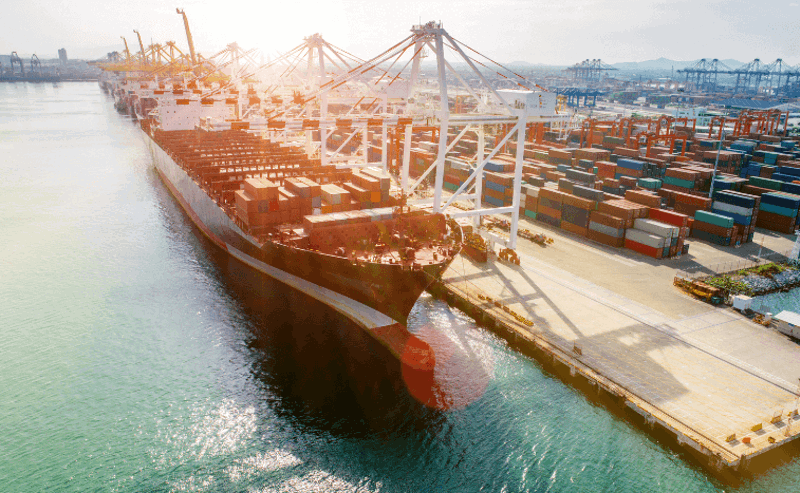The global supply chain continues to experience shortages, congestion, and more. Here’s what manufacturers and other shippers can expect for 2022 and how stakeholder collaboration and supply chain technology can help.
In March of 2020, the World Health Organization declared COVID-19 a global pandemic, prompting stay-at-home orders and grinding many parts of the supply chain to a halt. Initially, consumer demand dropped. Companies cut their manufacturing capacity, canceled container shipments, liquidated inventories, and let workers go. That year, 3% of the 22 million job losses in the U.S. were labor jobs.
When summer came, people began shopping online again, causing a sudden e-commerce boom. However, many companies couldn't manufacture and transport goods at the rate needed to meet that overwhelming demand. Businesses also faced talent, material, and container shortages, causing increased delays, higher shipping costs, and uncertainty. These problems continued throughout 2021. Supply chain managers reported heavy disruption, and the cost of shipping a container from China to California increased 13-fold during the pandemic.
Limited supply chain visibility may partially explain why the effects of the pandemic on the supply chain continued throughout 2021 and the first couple of months of 2022. When companies don’t have complete visibility, they can’t effectively plan for the future. Between that and long lead times, companies aren’t able to accurately predict and quickly adapt to consumer demand, so relief may still be months away.
What’s Next
Unfortunately, these supply chain disruptions, delays, and rising prices will likely persist well into 2022 or even 2023. In fact, container and air freight shipping rates may become three to four times more expensive than last year.
The U.S. economy is expected to grow, but labor will likely still be in short supply, despite recent sunny jobs reports, which may exacerbate supply chain issues. Until port congestion clears, consumer demand decreases or container circulation improves, prices will stay high, and the global supply chain will remain delicate. While the Omicron wave of COVID-19 seems to be receding in the U.S., threats from a new coronavirus strand, a natural disaster, a further surge in demand or a labor strike in the ports on the West Coast could impact distant parts of the supply chain and affect lead times. However, consumers will still demand low prices and fast shipping times, so companies need to be prepared.
While the pandemic pushed the supply chain to its limit, many of the problems and inefficiencies have existed for decades. COVID-19 simply exposed these vulnerabilities. “These substantial, fundamental problems won’t disappear once goods start flowing again,” Blume Global’s CEO Pervinder Johar said recently. “We cannot simply return to the status quo and hope that things will get better.”
He added, “Concentrating on a single stakeholder in a network will do little to ease congestion.” Instead, stakeholders will need to work together to improve freight flow. To do this, Johar encourages embracing digitization and using innovative supply chain technology solutions to connect with one another and stay ahead. “Working together on a common digital platform will optimize and add fluidity to the entire network,” he continued. Stakeholder collaboration is, undeniably, the key to improving current conditions.
By using supply chain technology, companies can easily collect and share data with their partners in real-time, allowing for a more streamlined supply chain and more accurate forecasting. Companies will be able to map their entire supply chain to fully understand risks and vulnerabilities. This additional visibility and communication will help them make informed decisions when planning manufacturing, transportation, and distribution for the future. They’ll be able to diversify their supply base to reduce risk, remain agile and keep up with today’s consumers’ demand for new products.
Companies can use artificial intelligence (AI) and automation to streamline logistics operations, accelerate repetitive tasks, eliminate human errors and combat the worker shortage. Supply chain technology can also help companies optimize their ROI, improve the customer experience and adopt elastic logistics to quickly react to market fluctuations.
This year will likely be challenging for the supply chain industry, but stakeholders can navigate this congested logistics world if they work together. Collaboration and supply chain technology are essential to surviving and thriving in today’s uncertain environment.
Blume Global is committed to sustainability and innovation and is the world’s first carbon-neutral supply chain technology provider. Strategize for the unknown by preparing for disruption. Blume provides real-time visibility to inventory in transit combined with advanced exception alerts and the ability to execute on routing, service level, and other recommendations can get shipments back on track.
contact us
Contact Us

